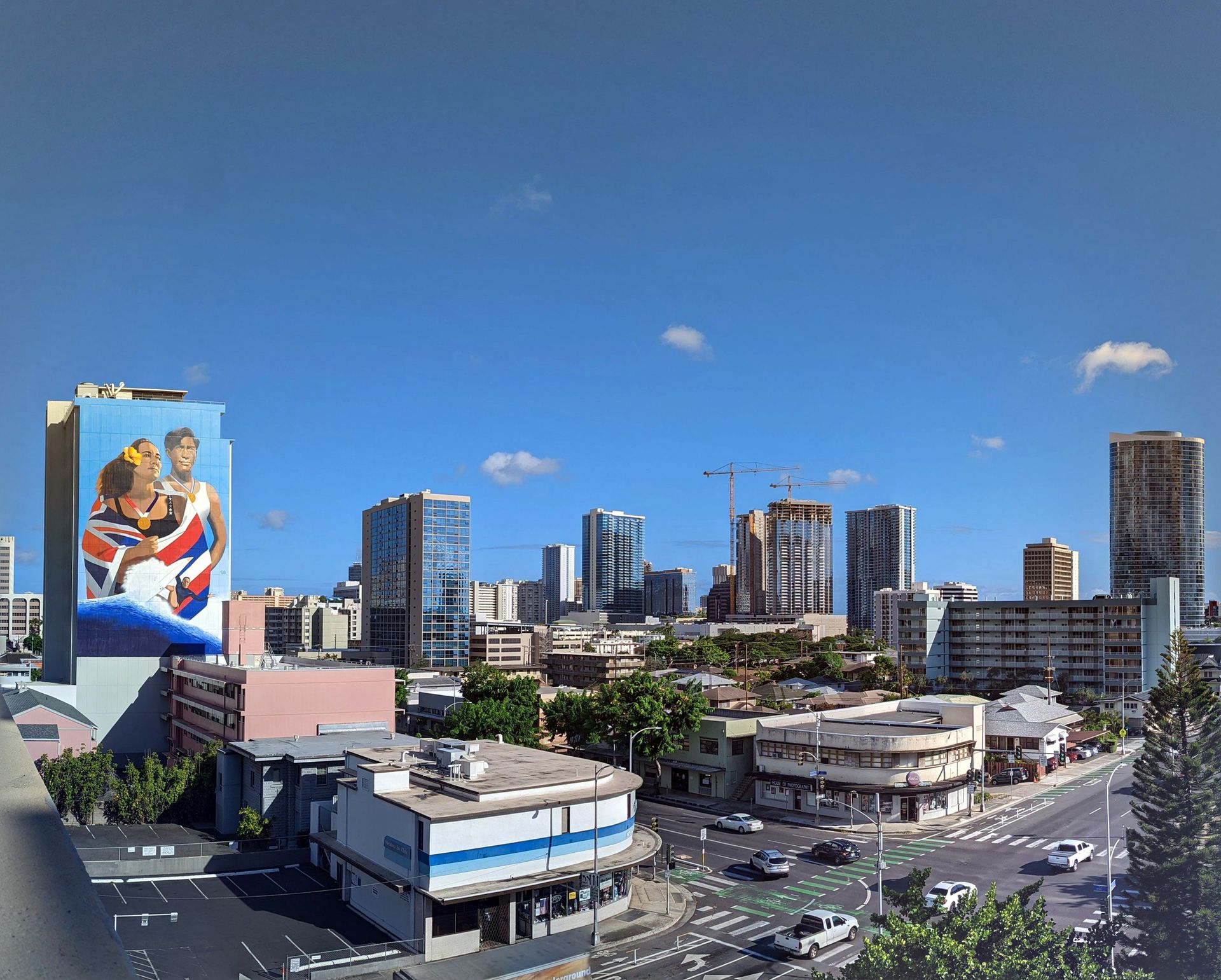
Quarterly Newsletter July - September 2023
P R I N T | R E P L I C A The September median sales price for single-family-homes was $1,050,000 (4.5% lower than September 2022) and for condos was $532,500 (6.0% higher than September 2022). Higher interest rates continue to weigh on demand with 16.5% fewer single-family homes selling in September compared to the year before and 24.2% fewer condos selling. The market continues to search for a bottom. There were 7.6% fewer single-family homes listed in September and 14.1% fewer condos.
The S&P CoreLogic Case-Shiller National Home Price Index fell 0.5% lower in May 2023 compared to May 2022. The price reduction was the second month in a row as mortgage rates bounced around between 6% and 7%. Unusually low inventory has helped prevent greater price reductions as homeowners become more reluctant to sell and trade their low mortgage rate for a higher one. The median existing-home sale price dropped 0.9% in June compared with June 2022.
UHERO published Hawaii Housing Factbook in June to specify the challenges Hawaii residents face when trying to pay for housing. UHERO just released the Hawaii Housing Dashboard to compliment the factbook and allow users to delve into this interactive platform and pull up statistics about Hawaii’s neighborhoods. For instance, over one-half of Oahu renters spend more than 30% of their income on rent and over one-quarter of renters spend more than 50% on rent. The median housing age is 47 years and only 24,000 housing units have been added over the past five years. The median length of time to acquire a housing permit stands at 153 days. To access the dashboard, visit the website:
https://uhero.hawaii.edu/analytics-dashboards/housing-dashboards/
Sign up for our email newsletter using the QR code above with your smartphone camera.
A Mixed Plate of Talk Story
Maui wildfires fanned by high winds from Hurricane Dora killed 98 people and destroyed historic Lahaina and damaged or destroyed more than 2200 structures including 2,000 homes. More than 2,000 people were housed overnight on August 8th, and 4,000 visitors were flown to Oahu on August 9th. Fourteen people had to be rescued after jumping in the water to escape the Lahaina wildfires. Three victims have been flown to Oahu and were treated at Straub Hospital’s burn unit. 100 firefighters fought the blaze and high winds knocked over 30 utility poles causing additional fire and destruction. Many flights to Maui have been canceled and visitors are encouraged to check their reservations before making the trip. Officials don’t expect to know the extent of the damage for weeks. The state Attorney General started a formal investigation into the decision-making and policies before and during the wildfires. No sirens were activated to warn residents of the incoming danger and many in Lahaina woke up in the middle of the night to their neighborhood burning down, too late to escape. The Hawaii Emergency Management Agency and Maui Emergency Management Agency triggered alerts to cell phones, TV, and radio, however, Lahaina was without power for most of Tuesday with power poles and some cell phone towers down. Police and fireman were going down streets with their sirens on, knocking door-to-door. Many of the dead were found in burned out cars trying to escape.
Lahaina firefighters were denied their primary tool for fighting fires when the town’s water system collapsed. The town relies on creek surface water and ground water pumped from wells which were strained from the current drought. The deputy director of water resource management from the state Department of Land and Natural resources delayed the release of water to landowners who wanted to protect their property from the fire for much of the day. The water was not released until 2 ½ hours after the fire had spread and nine hours after the initial request for the water. Firefighters noticed that the water pressure was dropping when the fire jumped over the highway and consumed houses. The resulting water leaks from melted pipes in the destroyed homes resulted in the fire hydrants running dry. Additionally, hurricane force winds prevented helicopters from carrying seawater inland to dump it on the wildfires. Firefighters had to halt their attempts to stop the fire and risked their lives to save as many Lahaina residents as they could.
Hawaiian Electric Company (HECO) and Maui police have come under criticism for blocking traffic out of Lahaina while the wildfires spread. Maui police claim they were directing traffic from downed power lines even though HECO had de-energized them six hours prior and the downed lines posed no threats. Residents spent up to 2 ½ hours trying to navigate Lahaina’s narrow streets since the two main thoroughfares were blocked by police or HECO’s utility workers. No timeline has been established for releasing a detailed analysis of the town’s evacuation.
The University of Hawaii Economic Research Organization’s (UHERO) third quarter forecast includes the immediate impact of the wildfires on Maui’s economy and their estimates for the eventual recovery. UHERO reported Maui visitor numbers plunged by nearly three-quarters immediately following the wildfire resulting in revenue losses of $13 million per day. Visitor numbers have just begun to recover in late September. Visitor arrivals are expected to reach 50% of 2022 numbers by the end of the year and reach 80% by the end of 2024. Unemployment numbers have surged to over 11% and the state is once again struggling to process the claims because they still have not updated their computer systems. The wildfires displaced about 7,000 individuals and it will take years to replace the destroyed housing. UHERO expects the impact on the rest of the state will be muted. Tim and Tracey’s friend has a tour business on Oahu, and she has had several cancellations since visitor plans included a visit to Maui. Time will tell how much Oahu visitor numbers will be impacted through 2023 since many people have already made and cancelled planned trips to Maui and elsewhere.
When Maui Mayor Richard Bissen on September 27th announced that West Maui would be gradually reopened for tourism beginning October 8th, some members of the Lahaina community protested. The displaced residents want their kids back in school, a plan for underground utility lines, establishment and better management of firebreaks with expanded use of reclaimed wastewater, and water for irrigation of traditional crops. The demand for resources appears at odds with the island losing $13 million per day in lost visitor revenue.
The first day of the planned opening on October 8th was quiet with small groups gathered to honor family and friends lost during the wildfire at the intersection of the Lahainaluna Bypass and the Lahainaluna Road into West Maui. People laid fresh flowers at the site where crosses represented victims of the wildfires. Flags from Hawaii, the Philippines, Japan, Mexico and more represented the nationalities of those that lost their lives. Some local leaders do expect things to get more tense if the county and state continue to fail in support of the families in need.
“Tree-huggers” are working to revive a 150-year-old banyan tree in Lahaina after an arborist found no significant signs of charring or cracking of the main trunk or root system and the ground did not appear to be burned and the benches were still standing. The group is watering the tree and ground daily and will put down a layer of compost to help the tree heel. Groups of leaves were seen sprouting on Lahaina’s banyan tree in October, giving the community hope that the historic tree will survive. Arborists continue to volunteer their time to aid the tree’s recovery.
Governor Josh Green issued an emergency proclamation aimed at building more affordable housing by relaxing state and county scrutiny of affordable housing projects to speed construction. Current regulations add approximately $233,000 to $335,000 to the cost of building a new home. The oversight does delay projects, yet some minimal oversight by neighborhood organizations does prevent building housing without sufficient parking. Per usual, the governor relies on government to solve the problem when government originally created the problem. A recent article describing the drama around a 243-unit complex that includes affordable housing repeats Hawaii’s failure at creating and maintaining housing. The Hawaii Community Development Authority (HCDA) failed to pay maintenance fees two years ago, failed to address hot water distribution problems and mold, and recently threatened to evict two tenants over past due charges of $42 and 50 cents. The residents have had enough and are making their complaints public. HCDA officials complain that rental income fails to pay management and repair expenses and the current deficit is roughly $25,000. The problems identified in the Honolulu Star Advertisers article will likely grow if the state builds and manages 50,000 more affordable housing units per Governor Green’s ambition.
A Honolulu wastewater executive, Milton Choy, was sentenced to three years in prison for a multi-million-dollar bribery scheme, paying over $2 million in bribes in return for $19.3 million in sole-source contracts. Choy paid Stewart Stant, the then Director of Maui County Department of Environmental Management who spent the money on hostess bars, luxury hotel stays, travel, and jewelry. Choy also paid bribes to convicted former Senate Majority Leader J. Kalani English and former state Representative Ty Cullen. The bribery scheme is considered the largest in Hawaii’s history.
Bill Wong, the architect who pleaded guilty to bribing members of the Department of Planning and Permitting (DPP), still has an active license and is submitting plans for permitting approval. The Department of Commerce and Consumer Affairs (DCCA), the state’s licensing authority, has yet to take formal action against the architect. The DCCA’s only comment was that a complaint was opened and pending with the Regulated Industries Complaints Office (RICO), the complaint department. The DCCA can suspend or revoke licenses for failing to maintain a record of “trustworthiness, fair dealing, and financial integrity,” and after a criminal conviction “directly related to the qualifications, functions, or duties of the licensed profession or vocation.” Wong was sentenced in July and will be serving time starting January. It will be interesting to see if he loses his license before reporting to jail.
The success of community centered visitor management at Ha’ena State Park on the North Shore of Kauai has state officials hoping the effort can be duplicated throughout the state to create a more sustainable tourist industry. Hawaii residents chaffed at 10.4 million visitors mobbing the state in 2019, straining the state’s park facilities. The state park set a daily visitor cap, charges nonresidents an entry fee, and visitors must pay for parking when they use the park’s shuttle service. Community members meet visitors when shuttles arrive to make sure they have enough water, point out lifeguards on duty, and give times to leave different hiking spots to make the last departing shuttle at 6:40 pm. The area was a breadbasket for Native Hawaiians before the state park was created and poor management resulted in invasive plants and trees overwhelming the landscape. Local families started caring for the park by ripping out invasive trees, restoring a traditional waterway, and planting kalo (taro) for the community. A 60-page document on replicating the model has been published and communities like Kealakua on the Big Island and Wai’anapanapa on Maui hope to implement the program. The Hawaii Tourism Authority and Hawaii county funded stewards at Waiuli and Lehia beach parks to manage visitor traffic.
The work to restore the Koko Crater Stairs, also known as the Stairmaster to Hell, was completed in early July. The City and County of Honolulu announced that a new 71 square foot platform replaced the deteriorating metal grate platform to the tune of $426,800. The Kokonut Koalition had shamed the city into replacing the platform after volunteers restored the stairs at minimal expense. The city had originally planned to just remove the old platform.
The University of Hawaii (UH) is wrapped up its $30 million expansion of the Clarence T.C. Ching Athletics complex to raise seating capacity from 9,300 to the Division I minimum of 15,000 seats for the September 1st opener. UH was forced to upgrade its practice field to a Division I game field when Aloha Stadium was condemned in 2020. While UH scrambled to provide a home field for its football team, the state has not even demolished the rusted out and unusable stadium.
A lost sea turtle hatchling was recently rescued at a skate park and placed in the ocean. Hatchlings rely on moonlight and celestial light to find the shore when emerging from their nests. Apparently, this hatchling was one of fifty that became disoriented by artificial lights and headed mauka (towards the mountain) instead of makai (towards the ocean) while only seven of their siblings headed in the right direction. More sea turtles are nesting on Oahu and the biggest threat to the hatchlings is artificial light. Researchers encourage the public to refrain from using flashlights on the beach during nesting season and keep at least 10 feet from sea turtles and their nests. The city turned off the lights at Sandy Beach on Sunday in anticipation of hatchlings emerging from six honu nests. The lights will be turned back on when researchers verify that the eggs have hatched.
Tim and Tracey had to say good-bye to their dog Buddy after 14 years of loyal companionship. He brought great joy to the Stott-Kelley family over the years and will be sorely missed. Two days later, Tim and Tracey welcomed a new seven-month-old yellow-lab puppy into their home, appropriately named Buddy. While he can’t replace the first Buddy, he has both of them wrapped around his “giant” puppy paws.
Warning Signs
Tim and Tracey have owned investment real estate for more than 20 years and Tim has lead Stott Property Management for the past 14 years. During that time, they have learned the value of hiring competent licensed professionals to manage investment real estate owned from a distance.
No Monthly Revenue: Stott Property Management, LLC has taken over accounts where the owner did not receive any income for months. In one extreme case, the owner had not received any income for almost a year without any communication from the property manager. The reasons for the lack of income ranged from excessive vacancies, failure to collect rent from dead-beat tenants, allowing friends and relatives to live in a unit rent-free, to outright fraud.
Monthly Statements: Your property manager should send you statements once per month at a minimum. These monthly statements should show your account balance at the beginning of the month, the amount of rent collected, all of the expenses paid on your behalf including the property management fees, the amount of the proceeds that you should have received, and the ending balance. Paid invoices for all the expenses that your property manager paid on your behalf should accompany the statements.
Communication: Effective, two-way communication is the linchpin for any successful investor / manager relationship. Communication comes in the form of financial statements, e-mail, phone calls, and face-to-face meetings. Tim and Tracey think that effective communication is so important in their business, that both Stott Real Estate, Inc. and Stott Property Management, LLC have full-time receptionists whose primary responsibility is to answer the phones. There is nothing more frustrating that being a customer that has to traverse “voice-mail hell” during normal business hours.
There are property managers that do everything possible to avoid phone calls and meetings. Uncomfortable and unpleasant conversations are part of the business since moving, money, and family issues are some of the most stressful situations that people deal with. Communication should be even more of a priority during a crisis and there could be a real problem if you aren’t hearing from your property manager.
Constant Turnover: Many larger property management companies have property managers that are independent contractors while centralizing their bookkeeping and maintenance services. One sign of potential problems in an office is a constant turnover of property managers resulting in someone new repeatedly taking over management of your property. Constant turnover can result in a loss of knowledge regarding your property and your investment can suffer if inexperienced managers take over.
Mergers: Some large companies on Oahu have merged over the past couple of years to consolidate operations and save money. Poorly executed mergers can result in operational chaos that can negatively impact your investment. You may want to consider a change if your company has been bought out or has merged several times and you are no longer receiving the level of service that you require.
Stott Property Management, LLC has taken over many accounts from property managers that raised one or more red flags. Their client’s calls either went unanswered or the property manager would make excuses for failing to return phone calls and e-mails and to why the statements were not being delivered. By the time Stott Property Management took over, the affected owners lost thousands of dollars in lost income for various reasons including outright fraud. Pay attention to the warning signs and start interviewing alternatives if your current property manager gives you reasons to be concerned.
Security Deposits
Note: Stott Real Estate, Inc. and Stott Property Management, LLC do not employ attorneys and its employees are not authorized to give legal advice. Stott Real Estate, Inc. and Stott Property Management, LLC encourage individuals to seek legal advice from licensed attorneys before enforcing the rental agreement or acting against a tenant or any other individual.
The purpose of the article is to highlight limitations and deadlines required by Hawaii Revised Statutes (HRS) Chapter 521, the Landlord Tenant Code, and provide a guide to properly administer tenant security deposits during check-in and after checkout. Security deposit handling requirements vary state by state, so it is critical that you know the specifics for each state in which you own rental property.
The state of Hawaii defines a security deposit as money deposited by or for the tenant with the landlord to be held by the landlord to:
- Remedy tenant defaults for accidental or intentional damages resulting from failure to comply with section 521-51, for failure to pay rent due, or for failure to return all keys, including key fobs, parking cards, garage door openers, and mail box keys, furnished by the landlord at the termination of the rental agreement;
- Clean the dwelling unit or have it cleaned at the termination of the rental agreement so as to place the condition of the dwelling unit in as fit a condition as that which the tenant entered into possession of the dwelling unit;
- Compensate for damages caused by a tenant who wrongfully quits the dwelling unit;
- Compensate for damages under subsection (b) caused by any pet animal allowed to reside in the premises pursuant to the rental agreement; and
- Compensate the landlord for moneys owed by the tenant under the rental agreement for utility service provided by the landlord but not included in the rent.
The security deposit must not exceed a sum equal to one month’s rent. The landlord may require a pet deposit not to exceed one month's rent in addition to the security deposit to compensate the landlord for any damages caused by any pet animal allowed to reside in the premises pursuant to the rental agreement. The additional deposit may not be required for a service animal or emotional support animal.
Please note that Hawaii limits the security deposit to the equivalent of one month’s rent and the landlord may only collect a full first month’s rent when the tenant checks in. Some clients have asked Stott Property Management, LLC to collect a security deposit plus the first and last month’s rent which is prohibited by the state of Hawaii. Standard business practice specifies that the security deposit shall be paid using certified funds (bank check, money order, or cash) and you as the landlord should not relax that requirement. Successful con artists are very skilled in developing trust before taking their victim’s treasure and accepting a personal check or allowing a tenant to pay the security deposit after moving in exposes you to the risk of being conned. It takes a finite amount of time to sue for possession of the rental property after turning over possession of the keys to a tenant resulting in the loss of rent, court fees, and attorney fees.
Stott Property Management, LLC’s rental agreement specifies that the security deposit may not be used to pay last month’s rent and we enforce it by charging a late fee if the last month’s rent is not paid by the due date specified in the rental agreement. We are asked repeatedly by tenants and clients if the security deposit can be used for rent or other repairs while the tenant currently occupies the unit. Stott Property Management, LLC maintains that the security deposit must remain the security deposit trust fund until the tenant checks out and turns over the keys. This policy maintains and enforces that the security deposit may only be used to pay for unpaid charges and tenant caused make ready cleaning and repairs after the tenant checks out. The security deposit remains the tenant’s funds and may not be spent on any expenses until the tenant checks out and voluntarily returns possession of the rental property to the landlord.
The landlord has fourteen days to process the security deposit if the landlord intends to withhold a portion or the entire security deposit for unpaid charges and make ready expenses due to a tenant’s actions in inaction. The landlord must notify the tenant in writing of any unpaid expenses and charges that the security deposit is being used for with copies of estimates or paid invoices for make ready repairs and cleaning that the tenant is responsible for. The fourteen days is a hard deadline and Stott Property Management, LLC has witnessed judges in small claims court order landlords to return the security deposit in full to the tenants even when the landlord provides documentation showing that the tenant owed the money.
The landlord has the authority to keep the security deposit in full if the tenant is absent from the rental for twenty continuous days without notifying the landlord. Stott Property Management, LLC has a policy of notifying the tenant in writing of the total rent the tenant is liable when a tenant “wrongfully quits” or breaks a lease. The letter states the amount of the remaining rent the tenant owes minus the security deposit and is mailed to the tenants forwarding address or rental address (if the tenant does not provide a forwarding address) and a copy is posted on the front door of the rental property. This step helps meet the security deposit processing requirements even if the tenant tries to argue that he or she properly terminated the lease. A follow-up letter is mailed to the tenant’s last known address if a new tenant moves into the property and lowers the amount owed by the previous tenant.
The state of Hawaii is very specific in how a security deposit must be handled and failure to follow the statute can be very costly to an uninformed landlord. Stott Property Management, LLC recommends that you read HRS 521-44 in full and establish policies abide by the requirements established by state law. Failure to do so can be costly and increasingly so if a judge determines that the violations are intentional.
Odds & Ends
Lowering Insurance Rates: Inflation has driven insurance rates sharply higher this year and some homeowners and raising their out-of-pocket deductible to offset the insurance company’s rate hike. One couple in the U.S. had their insurance premium raised from $1,600 per year to $2,700 per year due to hailstorms the previous year. By raising their deductible from $5,000 to $10,000, they lowered their premium to $1,100 per year. The $1,600 year savings will pay for itself if the couple does not have a claim in the next four years.
Homeowners should weigh the risks of raising their deductible before making the decision. If you live in an area where serious storms are common, then raising the deductible might not be the best idea. However, if the chance of experiencing expensive home damage is low and the homeowner has not made claims in the past, then raising the deductible is most likely a good financial decision.
If you decide to raise your deductible, then you should add the deductible to your emergency fund in an interest-bearing account. The interest earned can add to the annual savings. Running up a credit card bill because you don’t have the funds available if you suffer home damage will simply add to the costs and make your financial situation worse.
Searching for Yield: The Wall Street Journal recently reported that some of America’s largest landowners are having problems finding homes to buy at prices they are willing to pay. The lack of supply and higher interest rates have made it much more difficult to buy homes at a price exceeding the cost of capital. In a real estate world where returns are 4% return on equity, the 5% interest banks pay looks very enticing.
One large landlord has been selling property whose values have appreciated to the point of yielding less than 4% and putting the money in the bank. If a small investor is in a similar situation, then he or she should think twice before following a similar strategy. While a large company has options for offsetting capital gains and avoiding taxes, a small investor has fewer options. The federal capital gains tax is 15% for married couples filing jointly earning between $89,250 and $553,849 and 20% for married couples filing jointly making more than $553,850. The rates and income levels change based on how taxes are filed so you should check with your tax advisor. States often tack on an additional capital gains tax (Hawaii’s is 7.25%). Therefore, a small investor should estimate their capital gains taxes before deciding to sell. Your returns could end up shrinking if you have a large capital gains tax bill.
The only way to increase your returns and defer capital gains taxes is by completing a 1031 exchange. If you own a rental property in an expensive home market with low cash flow, like Hawaii, then you may find rental properties providing higher positive cashflow elsewhere in the United States. Please contact us at home@stott.com if you would like to explore a 1031 exchange.
Must Have Amenities and Lease Terms: Choosing the correct investment property from the beginning is paramount. Must have amenities vary based on the region of the country your investment property resides and the type of renter you are looking to attract. This article will focus on the most desirable traits for long-term rental properties (a lease greater than six months) on Oahu. Most tenants today look for a rental that have at least one assigned off-street parking space (two is optimal for a two- or more-bedroom rental), stove, oven, refrigerator, dishwasher, washer/dryer, and air conditioning. Air conditioning has become much more important over the past decade and it has a measurable impact on rents and vacancy rates.
When it comes to lease terms, allowing pets has the greatest impact on rents and vacancy rates. The landlord typically has the discretion when the rental property is a single-family home. Investors targeting long-term tenants should verify that the association allows pets and the type and size of pets allowed. Please note that if you refuse to allow pets, then it is better to buy a condo in an association that does not allow pets so that you minimize your competitive disadvantage. Please also note that a tenant could still bring in a pet into the rental if they have a doctor’s note claiming that the pet is an emotional support animal.
The list of must have amenities and lease terms is not a buffet of items that you can pick and choose from. A rental missing one of the appliances, or one that does not allow pets, will turn off a significant percentage of potential renters. While most rentals do offer a full kitchen and washer/dryer, many still lack air conditioning or prohibit pets. Over the past three years, Stott Property Management, LLC has witnessed rental properties languish on the market because the client refuses to install air conditioning and/or allow pets.





